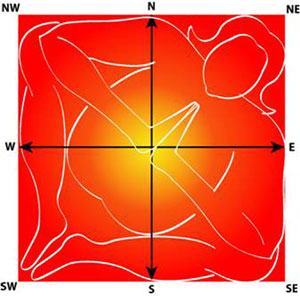
Terms used in Vasthu Sastra
In the ancient Indian science of architecture, the Vasthu Purusha Mandala is the metaphysical plan of a property. It is the symbolic representation of all the physiological and psychological changes that take place within a dweller as well within his or her property.
The Vasthu Purusha Mandala is a ” cosmic man ” who is believed to be present in every plot of land and is a very important aspect of Vasthu Sastra. This “man” is said to lie with his face and stomach touching the ground, with his head in the north-east and legs in the south-west.
The Mandala is a location plan for a proposed building and it has been found that buildings constructed in accordance with the rules of the Vasthu Purusha Mandala have been conducive to the health of owners.
Vasthu Sastra says a human being is both a material body and subtle energy or spirit within it; with the Vasthu Purusha Mandala, both the human body and a plot is compared. The Vasthu Purusha Mandala, or sacred is seen as the living energy of a physical structure and is connected to it in the same manner our body and spirit are connected.
If the layout of dwelling fosters a flow of energy that supports the Mandala, then there will be harmony within the house. A house built following Vasthu principles satisfies the Vasthu Purusha Mandala by allowing the flow of cosmic energy to be in balanced. his will yield good things to the occupant.
The ideal shape of the Mandala-or plot of land –should be a square or rectangle because the “cosmic man’s” body fits within it. If the shape is irregular, it will result in cutting off some parts of the cosmic man, which will affect the well-being of the occupants of the plot.
Right arm
Right arm
If, for instance, Vasthu Purusha has no 'right arm', the dweller will lose wealth and the women in his house will not have peace of mind.
Left arm
Left arm
If its 'left arm' is missing, the dweller will experience more expenditure than income. If the 'head' is absent, the breadwinner of the plot will lose assets and prosperity.
Feet
Feet
If the 'feet' are missing, the man of the house will be financially week and women will encounter family problems.
Cosmic man
Cosmic man
If the Vasthu Purusha Mandala, or 'cosmic man' has all this limbs in perfect shape, the dwellers of the house will be prosperous and enjoy bliss and happiness.
Art of placement
VASTHU Sastra is basically an Indian art of placement of things in a building or any enclosed space. In Vasthu Sastra, the house is compared to the human body; since man is nothing but a mass of vibrating energy, so is the building.
Vasthu Sastra stresses on the arrangement and placement of the five elements-ether, air, ire, water and earth in the correct proportions.
For a dweller to enjoy health, wealth, peace and prosperity, he or she must respect the cosmic energies in the respective quadrants. The direction and quadrant of the elements are determined via a compass.
It is imperative that one understands and distinguishes between direction and quadrant using a compass and not use something like the sunrise to determine direction as this could be inaccurate.
Direction refers to the dweller or any object that faces or points towards the eight compass
directions-north, south, east, west north-east, north-west south-east or south-west.
Quadrant or sector means the section of the building or plot you are in. A quadrant or sector on a plot of land or property is determined by dividing the building or the plot into nine squares. Each square is a quadrant.
